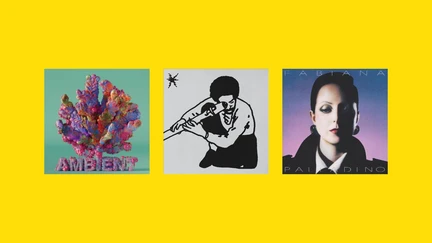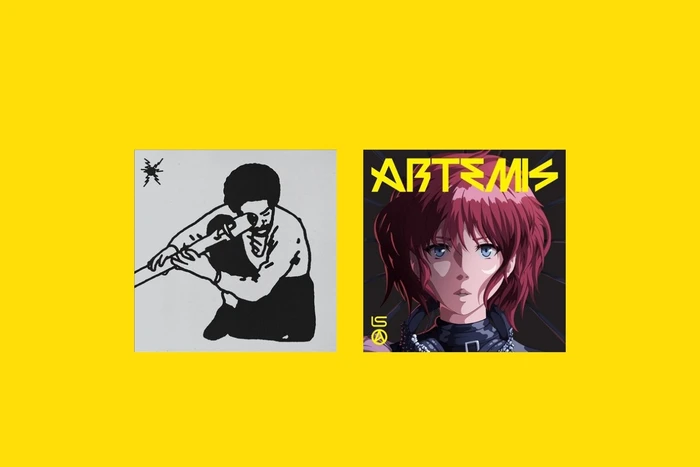April’s new music for Te Awe
Join us every month to cast an eye over the new material we have been buying for the music collection at our CBD Te Awe library.

I’m Mark, the Music & Film Specialist at Wellington City Libraries. I buy music for the CD & Vinyl collections, and also run the Libraries’ Wellington Music Facebook page). My Music Specialist colleague Sam, and Fiction Specialist (and avid music fan) Neil, join me every month to cast an eye over the new material we have been buying for the music collection at our CBD Te Awe library. We pick out some interesting titles across a range of music genres and try to limit our reviews to a few lines only. Can we encapsulate an entire album in just a couple of lines? [Ed. This is probably unlikely at this point]. Do we actually know anything about new music? Or, are we just too old to understand what most of this is banging on about? [Ed. This is more than likely]. Read on to find out…

Jon Savage’s ambient 90s : 1991-1996 / Savage, Jon
Neil Says: Jon Savage’s ambient 90’s is a sonic snapshot that evokes a particular time and moment in ambient music’s development. The nineties were a transitory phase in music, driven by new digital technology in the form of digital synths and samplers, and the arrival of new illegal recreational drugs. This potent combination spawned the rave and dance scene. As such, ambient music of the time is more connected to these scenes and is much more rhythmic, loopy and early sample driven, than the dreamy spacey analogue ambient works of the 70s or eighties. This excellent compilation does a fine job in capturing this scene…. Rave on, chill out.
Tigers blood / Waxahatchee
Mark Says: Waxahatchee (AKA Katie Crutchfield) returns with her 6th album, Tigers Blood. A more pronounced Americana effort, following on from 2020’s country-rock Saint Cloud, that moves completely away from the lo-fi indie sound of her early solo output. The key component of her music was always the intimate nature of her stories and her unique narratives, which often deified whatever music style was the most prominent on particular albums. The tight backing features Spencer Tweedy on drums, and MJ Lenderman duets on ‘Right Back to It.’ A relaxing set of tracks with a gentle front-porch vibe.
Desertshore / Nico
Neil Says: After the demise of The Velvet Underground the various members went off in their own directions to pursue their widely different musically careers, largely to great artistic success, if not always commercially. This could definitely be said of Nico’s works. By the time of her third solo album Desertshore Nico was in a creative phasey, despite battling various personal demons. She brought in fellow band member John Cale to co-produce the album who does a fabulous job. The resultant work has been described as the first prototype modern goth album. Whilst that is arguable, what isn’t in doubt is that this is a dark, brooding, bleak masterpiece; an object study of loneliness, alienation and inner nihilism. The album is minimalist and sparse in structure, with songs often only comprising of Nico’s vocals and harmonium playing, focussing the listeners attention strongly on these aspects. Several of the songs on the release were used in the film The Inner Scar which starred Nico, a still from the film is used on the albums cover.

Unreadable communication : Anxious recordings 1991-1993 / Curve (Musical group)
Mark Says: Curve were a seminal 90s UK cult band, whose loud industrial noise/pop mash-up of shoegaze, guitars and techno beats had the rougher edges polished off by later band Garbage, for a larger degree of commercial success. Essentially guitarist Dean Garcia and vocalist Toni Halliday, they released a series of acclaimed EPs before debut album, 1992’s Doppelgänger, made it to number one on the U.K. indie charts. The follow up, 1993’s Cuckoo was noisier and less approachable. The band split after its release, before reforming the late 90s for a run of sporadic album releases before Halliday finally called it quits in 2005. This box rounds up the first two albums and attendant EPs, previously collected as two Deluxe CD reissues in 2017. This is massive sounding music that still feels influential today.
The Carnegie Hall concert / Coltrane, Alice
Neil Says: Alice Coltrane was already an established jazz musician when she met her future husband John Coltrane in 1963. She was to become his main musical collaborator from that point on till his death in 1967. It was his death that triggered a deep and profound personal, spiritual and musical journey within her. During this time, she created a new form of jazz now called spiritual jazz; a deep, calming and meditative genre that uses music to search for redemption and peace from inner turmoil, without denying that turmoil. The music, whilst often mellow, also embraces elements of the chaos to be found within life, in a musical form aiming to create a holistic fully rounded acceptance of life. This stunning live recording with Alice playing piano and harp is a superb example of the genre. It is a rare recording of a benefit show for the Integral Yoga Institute done in 1971 and features a stellar line up of jazz luminaries, such as Pharoah Sanders and Archie Shepp amongst many others.
Fabiana Palladino / Palladino, Fabiana
Mark Says: The debut album from Fabiana Palladino (daughter of famous bass player Pino Palladino) may settle arguments around pastiche vs homage, or just invigorate them once again. Arriving 13 years since she began self releasing music, and 7 years after signing to the Paul Institute label where she would release only two singles, the album is an almost note perfect recreation of the 80s sophisti-pop/synthy R&B sound. From the pop of Jam & Lewis era Janet Jackson, to Prince, Kate Bush, and the 80’s R&B sound of producers like Kashif & Paul Laurence, it all sounds amazing. But is that enough? While there is no doubting the complexity, sophistication and musical skill on display, in both the music and the writing, can something that is clearly not ground-breaking in any real way still achieve greatness? The critics say yes on this one, so over to you…

New blue sun / Andre 3000
Neil Says: One of the most talked about albums from last year, now released on CD, was the André 3000 (one-half of the Southern hip hop duo Outkast) ambient album New blue sun; a seemingly bizarre musical left turn that saw him release an album with no rapping or even singing, but plenty of ‘flute jams’. The resulting album is a beautiful mellow release, that also demands the listeners attention. It has closer connections to ambient jazz or devotional new age music than it does rap of any kind, and the spiritual influence of Alice Coltrane or Pharoah Sanders can clearly be heard in the music, rather than their particular musical approaches. A fabulous and truly unexpected ambient release.
Artemis / Stirling, Lindsey
Famously axed after making the quarterfinals on season five of America’s Got Talent, American Lindsey Stirling continued to pursue a unique identity in music, combining violin and dance choreography with classical, pop, electronic and hip-hop musical stylings. Artemis is her fifth album and plays out like the grandiose soundtrack to an unreleased movie. EDM beats meets classical violin parts, meets ethereal vocals, meets swirling and cascading string arrangements. Artemis is the ancient Greek goddess of the moon, and also the name of the protagonist in this concept album, which follows her fictional journey through a neon shaded dystopia. Evanescence’s Amy Lee provides guest vocals on one track, but it’s Stirling’s show all the way. Definitely something a bit different from someone who has really defined the nature of what hybrid musicianship can be.